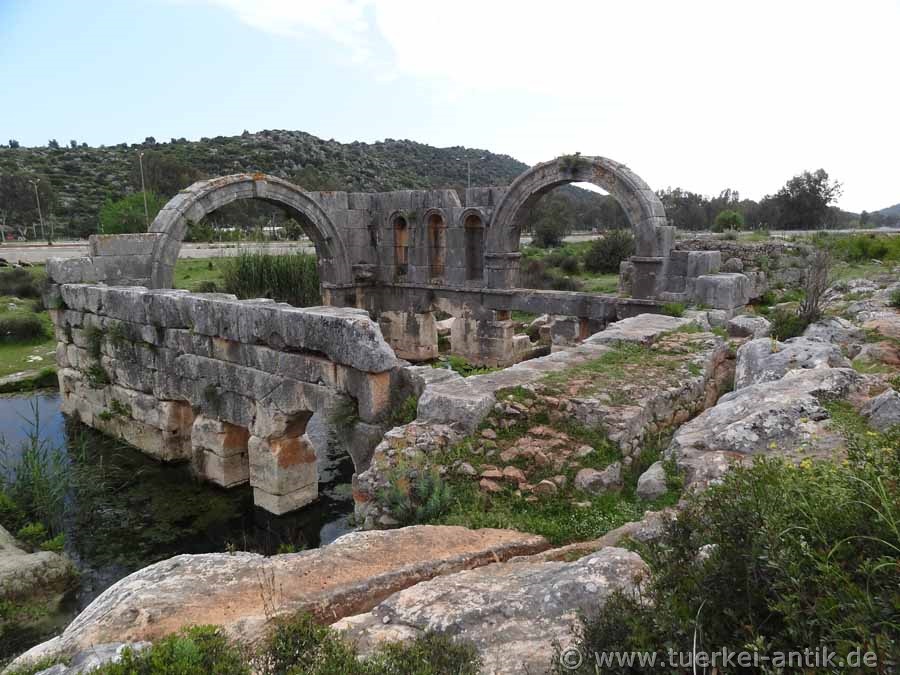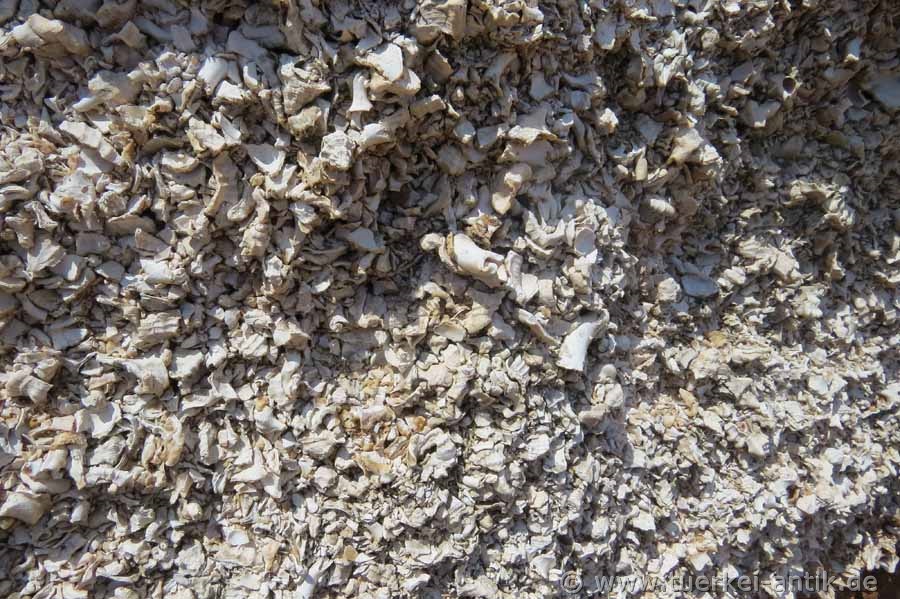 |
| Andriake | |||
|
|
|
||
| The apse of a basilica | |||
|
Andriake was the harbour of ancient Myra, five kilometres south-west of today's Demre in the Turkish province of Antalya, at the mouth of the Andrakos river (Kokar Çayı). Today the harbour has become silted up or marshy due to the river's alluvial deposits. |
|||
|
|
|||
| The Nymphaeum | |||
|
Already during the construction of the coastal road from Demre to Kaş in the 1950s, the former city area was cut through. Just above the entrance to the excavation site and to Çayağzı, as the "harbour" is called today, the ruins of the nymphaeum have been preserved. One can only guess what fell victim to the excavator during the construction of the road and the later 4-lane extension to the D400. But Andriake shares the fate of some ancient cities on the coast, which modern road construction could hardly avoid. |
|||
|
|
|||
| The modern entrance building to the ruins of Andriake | |||
|
For many years the remnants of the ancient Andriake lived a shadowy existence. This should change in 2013 and 2014. Andriake was made attractive for visitors by extensive construction and renovation measures. The well-preserved granarium was roofed over and converted into a museum. Remains of buildings on the Agora were renovated and the cistern below made accessible. A visitor centre was built at the entrance to the ruins and paved paths were laid out. |
|||
|
|
|||
| Paved paths today lead from the Visitor Centre to the Agora and Granarium | |||
|
|
|||
|
|
|||
| The Granarium, renovated in 2013 and 2014, is now a museum. | |||
|
Andriake was apparently much larger than the rather sparse remains of the former buildings today would suggest.
The importance of Andriake's location on one of the most important shipping routes. In the Roman imperial period, Andriake was one of the most important ports for the cereal fleet from Egypt alongside Patara, initially for Rome and increasingly for Constantinople from the 4th century AD. |
|||
|
|
|||
| Landed access to the sea | |||
|
Archaeological evidence points to the foundation of the village in early Hellenistic times. At that time, the branch extended over two hills on both sides of the harbour entrance. It was first mentioned in 197 BC, when Antiochos III conquered Andriake. In the course of the Roman occupation of the port in 43 B.C., a chain that secured the port entrance was broken. The apostle Paul waited here in the autumn of 59 A.D. on his journey to Rome for better winds and changed ships (Acts 27:5-6). |
|||
|
|
|||
|
|
|||
|
|
|||
|
Shells of purple snails |
|||
|
In the 6th century the harbour settlement experienced an upswing. Six large churches and two bathing facilities as well as numerous other buildings were built. The churches dating back to the end of the 5th or 6th century were three-nave basilicas, each with a semicircular apse on the east wall, almost certainly due to the production of the dye purple. Natural purple was (and still is) one of the most expensive dyes in the world. The toga of the Roman emperors was dyed with purple, while Roman senators and magistrates wore a purple stripe on their toga. The dye was/is
obtained from a gland of the purple snail (Hexaplex trunculus).
Thousands of snails had to be processed for one gram of the paint.
This made Andriake one of the most
important production sites of antiquity. |
|||
|
|
|||
| Buildings on the Agora | |||
|
The city was probably abandoned in the early Middle Ages, probably due to the increasing silting up of the harbour basin. In Ottoman times, a small fort was built on the western tip of the northern settlement hill. |
|||
|
|
|||
|
|
|||
| The large cistern under the Agora, today accessible | |||
| Photos: @chim | |||
| Translation aid: www.DeepL.com/Translator | |||
| Source: Wikipedia and others | |||
|
|
|||



